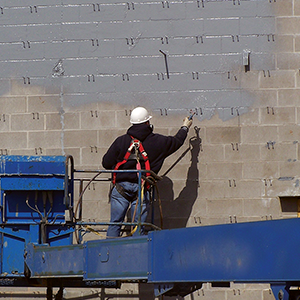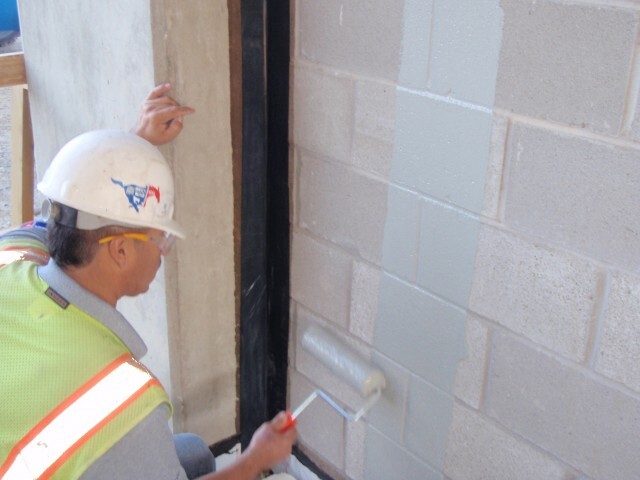A quality air barrier contributes toward an efficient exterior wall system by stopping air and any accompanying moisture from entering a building's interior. Air barriers come in several forms with various applications: fluid-applied air barriers and sheet applied.
Building designers and contractors typically consider substrate materials, building geometry, project conditions, weather conditions, climate, time, and the need for the air barrier to control water vapor when deciding between sheet-applied and fluid-applied air barriers.

Let's take a quick look at fluid-applied membrane air barriers, like Polyguard’s Airlok Flex® Fluid-Applied Air Barrier products, and the pros and cons of these systems.
Fluid-Applied Air Barriers
Fluid-applied air barriers provide a singular, monolithic coating that bonds to exterior sheathing without using fasteners. A high-quality fluid-applied air barrier contributes to durable, energy-efficient, and healthy commercial, institutional, and residential construction.
The Pros of Fluid-Applied Air Barriers
Fluid-applied air barriers provide numerous benefits that save time and money and help preserve the integrity and health of a structure.
Allows for Complex Detailing:
Fluid-applied air barriers easily adapt to complex substrate geometry.
Fluid-applied air barriers efficiently adhere to and waterproof various wall conditions and penetrations (like brick tiles or electrical conduits), detail wall openings, fasteners, and repair locations, and conform to uneven substrates, unlike sheet-applied air barriers that need cutting, folding, lapping, and sealing.
Quick Application:
A qualified installer can quickly spray-apply or roll the fluid-applied air barrier onto the wall substrate, saving time and money.
Fluid-applied air barriers do not require a primer, further saving time.
Moisture Barrier:
Creates a seamless moisture barrier by reducing installation errors that can cause holes, tears, or lap joints.
Air Barrier:
Prevents air leakage, lessen energy costs and condensation and improve occupant's comfort.
Wind Barrier:
Provides structural and full adherence, which creates stability and rigidity against strong wind events.
Durable:
Will not tear or lose effectiveness when exposed to outside elements during and after construction.
Safe:
Water-based fluid-applied air barriers are safe to use, easy to clean up, and V.O.C. compliant.
Rainwater Barrier:
Allow for pressure-equalized or pressure-moderated wall design, which lessens the risk of rainwater penetration through the wall system.
Lessen Repairs:
Protects the sheathing and rough openings from weather damage during and after construction, which minimizes repair or replacement costs.
The Cons of Fluid-Applied Air Barriers
Challenges in the application of fluid-applied air barriers require skilled installers and dry conditions.
Requires Skilled Labor:
A high-quality air barrier requires installers to apply fluid-applied air barriers, often with a specialized spray gun, at a constant, even rate to ensure consistent thickness and proper coverage at detail interfaces. Therefore the air barrier's performance does not depend on the product's manufacturing but on hiring qualified and skilled installers that strictly follow the manufacturer's instruction, not an easy task with today's skilled labor shortages.
Cost:
The need for skilled labor to apply fluid air barriers can make them costly.
Aversion to Moisture:
Fluid-applied air barriers will not fully adhere to moist, humid substrates. Incomplete bonding of the air barrier to the substrate will lead to the barrier flaking or pulling away from the substrate, forming holes in the barrier. For this reason, some contractors in regions known for moist and humid weather or frost-covered substrates hesitate to use fluid-applied air barriers.
Polyguard Airlok Flex® Family of Fluid-Applied Air Barriers
Easy-to-apply, single component Airlok Flex® Fluid-Applied Air Barrier products come in various options, including:
Permeable and non-permeable
Extended U.V. options
Low V.O.C.
You can easily apply (in one or two coats) our Airlok Flex® products with spray equipment or roller, detailing before or after application.

Airlok Flex®
In hot and cold temperatures, you can apply our single-component, patented, solvent-based Airlok Flex® fluid-applied air barrier (with a low V.O.C. option). Airlok Flex® offers numerous significant advantages:
Patented Thermoplastic Technology lessens application costs and exceeds industry standards
Installs quickly - up to 10,000 ft2 a day
It will adhere to treatments and transitional membranes, eliminating touchup
Applies in cold conditions (down to -20°F)
As a single component product, it eliminates mixing inconsistent performance and mixing
Airlok Flex® VP and V.P. L.T.
The design of single-component, acrylic-based, and cold fluid-applied Airlok Flex® VP and V.P. L.T. elastomeric membrane prevents moisture and air penetration while allowing water vapor to escape. Advantages of Airlok Flex® VP and V.P. L.T. include:
Application temperature of 40°F to 120°F
Available in low temperature (L.T.) option with use in temperatures 20°F and rising
V.O.C. content of less than 50 (g/l)
Permeable (10 Perms)
Water-Based
32 wet /16 dry mils (50 ft2 / gal theoretical coverage rate)
U.V. resistance of up to one year
Airlok Flex® WG and W.G. L.T.
The design of the Airlok Flex® WG (Weather-Guard) and W.G. L.T. air barrier provides superior U.V. resistance to meet the needs of thin mil applications and specifications.
Airlok Flex® WG and W.G. L.T. provide numerous advantages:
Application temperature of 40°F to 120°F
Available in low temperature (L.T.) version with use in temperatures 20°F and rising
Water-Based
VOC Content: 79 (g/l)
Permeable (21 perms)
U.V. resistance of up to two years
20 wet / 10 dry mils (80 ft2 / gal theoretical coverage rate)
The Benefits of Polyguard Airlok Flex® Fluid-Applied Air Barrier Products
Polyguard's single-component Airlok Flex® Family of Fluid-Applied Air Barrier products offer builders and architects a superior solution to their design and application challenges. Our easy-to-apply products save time and money during the application process and maintain their integrity for the structure's lifetime.
Contact our Polyguard architectural professionals for more on the pros and cons of fluid-applied air barriers.
